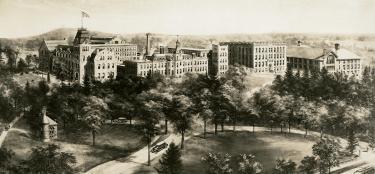Institutional History

John Boynton, an obscure and retiring manufacturer of Templeton, Massachusetts, had started life as a farmer, later becoming a peddler of tinware. All those years, he cherished a desire for practical education, but it remained beyond his reach until 1865, when at the age of 73, he became able to provide the means for other young people to secure what he had been denied. Boynton contributed $100,000, practically all of his wealth, toward the purpose of founding a technical school. All details of the plan he left to others.
The men who developed the program for what was to become Worcester Polytechnic Institute were David Whitcomb, Mr. Boynton’s cousin and confidant, the Reverend Seth Sweetser, a Worcester minister, Emory Washburn, former governor of Massachusetts, Stephen Salisbury II, the only surviving heir to Stephen Salisbury's Worcester legacy, Ichabod Washburn, a successful local businessman who founded the American Steel & Wire Co., and attorney George F. Hoar, later a distinguished United States senator. The comprehensive plan which they worked out, much of it written by Dr. Sweetser, provided for a combination of technical education and practical instruction in a commercial plant. It was an entirely novel idea at the time.
The charter of the Worcester County Free Institute of Industrial Science, as it was originally named, was signed May 9, 1865. Funds for a main building were raised among the citizens of Worcester. It was named Boynton Hall, in honor of the founder, who died a year and a half before the Institute began operations. The Washburn Shops were built shortly after Boynton Hall, and both were ready for use when the Institute opened on November 11, 1868.
Dr. Charles O. Thompson, a young man of great ability and vision, guided the Institute through its first fourteen years, and was largely responsible for the success of the unique plan. Sharing the problems of the first years were several equally competent administrators and teachers, including George I. Alden, Milton P. Higgins, John E. Sinclair, George E. Gladwin, and Alonzo S. Kimball.
There were 32 students in the first class, and succeeding classes were not much larger. Tuition was free to residents of Worcester County during the first decade. Courses of study included Mechanical Engineering, Civil Engineering, Architecture, Drawing and Design, Chemistry, and English, French, and German, with Physics added the following year. The original span of degree completion was three years in length, later increasing to three and a half years in 1872 and to four years in 1893. The name Worcester Polytechnic Institute was adopted in 1887.
For more content on the historical legacy of WPI, check out our two digital exhibits on WPI Founders and WPI Presidents.